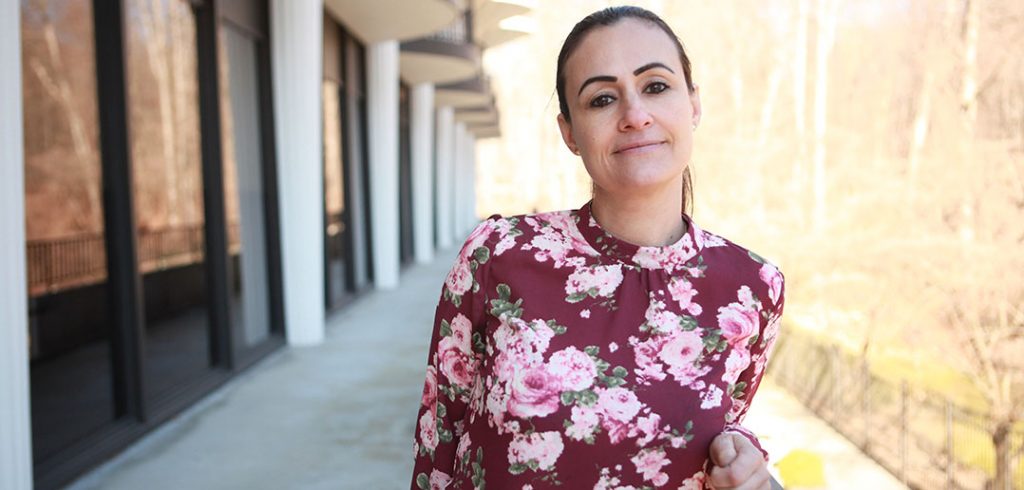Over her many years of clinical work, Dana Alonzo, Ph.D., noticed firsthand the “revolving door syndrome,” where the same patients returned to emergency rooms again and again.
This, she said, was despite advances in medications, and major campaigns that reduced the stigma of seeking help for mental illness.
“We’ve had no effect on the rate of suicide; in fact it’s higher than it ever was,” said Alonzo, an associate professor at the Graduate School of Social Service and director of Fordham’s Suicide Prevention Research Program.
She attributes the rise in part to the main focus of suicide prevention research over the years, which has centered more on desperate patients in the emergency room and less on those initially seeking outpatient services. Also, in much of the mental health research, patients’ sociocultural backgrounds are not taken into account.
“What differentiates social work from other mental health professions, like psychiatry or psychology, is that we look at more than just the individual person sitting in front of us. We look at their ecosystem,” she said. “We need to know the populations if we are hoping to help.”
Alonzo said that, up until recently, psychological research groups were largely made up of white males—and then the findings were generalized to everyone. It was a great advance when women and minorities were included, but much nuance is still lost on large groups. For example, Hispanics—although minorities—have a relatively low suicide rate when considered as a single group.
Even then, she said, looking at Hispanics as one whole group can lead to misinformation.
“When we break it down by Hispanic subgroups, we find that Cuban Americans and Mexican Americans have among the lowest rate of suicide of any ethnic group, but Puerto Ricans have a higher rate of suicide by ninefold,” she said.
Assuming risk for an entire group can also have a profound effect on communities, Alonzo said. Limited resources may be diverted to areas where they are not needed.
“A lot of evidence-based practices are largely based on quantitative research, which uses large randomized control trials and less of an emphasis on understanding the population,” she said. “We’re doing a disservice . . . assuming risk for populations that don’t have as much risk, and underestimating risk for populations who are at great risk.”
For example, Alonzo recalled an ad campaign for suicide prevention that appeared on buses running through a Washington Heights neighborhood, where the majority of the population is Dominican. That campaign might have been better placed in a Puerto Rican neighborhood, had research been available, she said.
Alonzo’s own research into suicide prevention found that the point of contact at which the research was conducted didn’t necessarily tell the whole story, because the majority of people who are at risk don’t go for treatment.
“This is a hard population to treat and study,” she said. “It doesn’t matter how great your evidence-based intervention may be if the at-risk individuals are not going to treatment to receive it.”
After finding that most people who came to the ER had already attempted outpatient treatment, Alonzo focused her research on outpatient centers with substantial caseloads.
“Somehow we had missed an opportunity to get them engaged with treatment,” she said. “Once someone goes to an emergency room saying that they’re thinking about suicide, then they’re going to the hospital—which is psychologically and financially burdensome.”
There, she works with patients who are coming in for a first appointment. She implements an onboarding procedure at the moment of intake, where suicide intervention can be initiated “in a way that’s realistic for overworked intake departments with large caseloads.”
“We need to make an impact early on, so that people who go in for an intake [will]experience an immediate benefit to treatment. [This will] limit the likelihood that they will then drop out and end up in the emergency room,” she said.
Alonzo’s intake procedure combines risk assessment and “engagement-focused intervention” alongside standard intake procedures. She said the intervention doesn’t require extensive clinical training. It can be used across personnel, and can be delivered quickly.
“It’s a brief motivational interview that involves personalized feedback on a risk assessment, and then follow-up contact,” she said.
She said most of the research that’s done on suicide focuses on the high-risk behavior, but not on engagement or adherence to treatment.
“We know very little about what keeps them in treatment,” she said. “What we do know is that those who are at the highest risk aren’t going to treatment to begin with, or they drop out very quickly and are not taking advantage of the evidence-based practices that exist to help mitigate their risk.”
She said her intake assessment tool provides personalized feedback that debriefs patients on their condition in everyday language—and with an awareness of their cultural background.
“We’ve learned that at-risk individuals experienced the standard risk assessment and treatment as impersonal and routine,” she said.
“By individualizing our feedback, the feedback itself can become the start of an intervention.”


